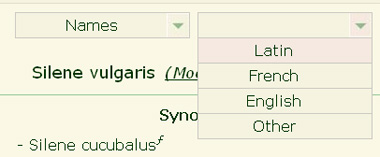Nomenclature5/5
5) On this web site
 On this web site, in the spec sheet pages of each species, for example on the one for Silene vulgaris, we can find in the top left corner the official English, Latin and French names coming from the sources cited in chapter 4 of this article.
On this web site, in the spec sheet pages of each species, for example on the one for Silene vulgaris, we can find in the top left corner the official English, Latin and French names coming from the sources cited in chapter 4 of this article.Under these names, when choosing the tab Names, you can choose from the following subtabs: Latin, French, English and sometimes Other.
 In the first three sub-tabs you will find the official name followed by his taxonomist, a list of accepted synonyms (according to Vascan) and in the sub-tabs for French and English, a list of other names that these species are designated in different other sources. These lists are not exhaustive.
In the first three sub-tabs you will find the official name followed by his taxonomist, a list of accepted synonyms (according to Vascan) and in the sub-tabs for French and English, a list of other names that these species are designated in different other sources. These lists are not exhaustive.It should be noted that, because of its importance as a reference, the names of those species that appear in the Flore Laurentienne and which differ from official names are listed with synonyms.
Some species show a fourth sub-tabs: Other, in this tab we find the name of this species in other languages, especially in Italian and Greek, as these communities are very active in Quebec, and the Epicurean that I am, and that you certainly are also, able us to identify the species in recipes coming from these communities.
 In the search page under the "Search by name" option, when this option is set to "All", not only the research is done on Latin, French and English official names, but also on the names for this species in Flore Laurentienne if they differ from the official names.
In the search page under the "Search by name" option, when this option is set to "All", not only the research is done on Latin, French and English official names, but also on the names for this species in Flore Laurentienne if they differ from the official names.
For example, the query "dentaria" will return as a result the species Cardamine diphylla because that in the book Flore Laurentienne we can find this species under the name Dentaria diphylla
By the way here is a little trick when doing a search by name, start your search with a short part of the name, it will avoid you to miss a relevant result for a simple spelling error, if too many results, you can then refine your search by increasing the length of the search query.



